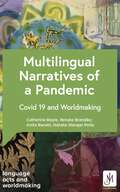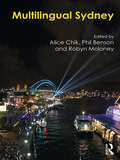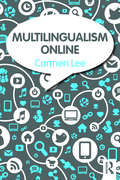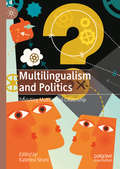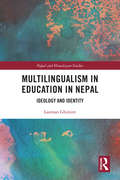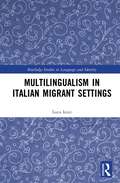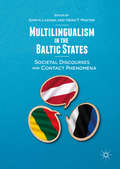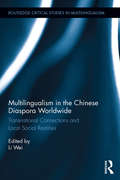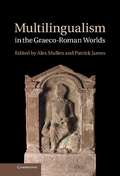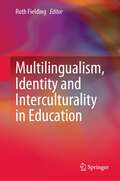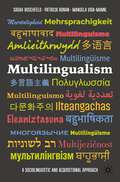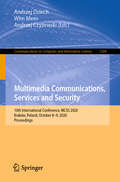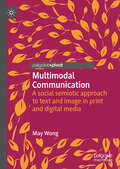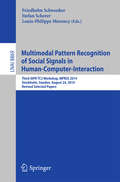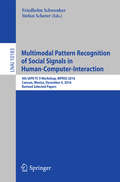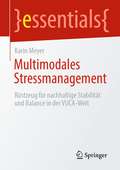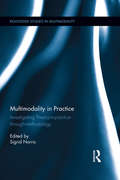- Table View
- List View
Multilingual Narratives of a Pandemic: Covid 19 and Worldmaking (Language Acts and Worldmaking)
by Various Professor Catherine BoyleWe narrate everything. We construct the world around us by telling its stories, shaping the language we use to describe what is happening to us; language that is used and adapted in the media in response to moments of crisis. This language in turn shapes how we see the world. This is what we call 'worldmaking'. When we look for solutions to problems, we so often start by telling stories to each other in our communities, stories that set a crisis in context, relate it to our historical experience, help us to understand it in the context of our local communities and contrast those stories to dominant narratives. In this way, language becomes a physical and material force in our world, through which we construct our personal, local, transnational and spiritual identities.'Worldmaking in the Time of COVID-19', the project that informs this book, was an early response to the experience of living through the COVID-19 pandemic - intended as a contribution to our collective understanding of the COVID-19 pandemic. Following comparison and analysis of over 1.1 million news articles from 117 countries in twelve different languages, this timely reflection follows the course of this investigation, with three main objectives: - to capture the languages of the early pandemic (January-April 2020); - to offer a transferable methodology for exploring world events in multiple languages; - and to share some of the key findings of researchers. Like all the volumes in the Language Acts and Worldmaking series, the overall aim is two-fold: to challenge widely-held views about language learning as a neutral instrument of globalisation and to innovate and transform language research, teaching and learning, together with Modern Languages as an academic discipline, by foregrounding its unique form of cognition and critical engagement. Specific aims are to:· propose new ways of bridging the gaps between those who teach and research languages and those who learn and use them in everyday contexts from the professional to the personal· put research into the hands of wider audiences· share a philosophy, policy and practice of language teaching and learning which turns research into action· provide the research, experience and data to enable informed debates on current issues and attitudes in language learning, teaching and research· share knowledge across and within all levels and experiences of language learning and teaching· showcase exciting new work that derives from different types of community activity and is of practical relevance to its audiences· disseminate new research in languages that engages with diverse communities of language practitioners.
Multilingual Narratives of a Pandemic: Covid 19 and Worldmaking (Language Acts and Worldmaking)
by Various Professor Catherine BoyleWe narrate everything. We construct the world around us by telling its stories, shaping the language we use to describe what is happening to us; language that is used and adapted in the media in response to moments of crisis. This language in turn shapes how we see the world. This is what we call 'worldmaking'. When we look for solutions to problems, we so often start by telling stories to each other in our communities, stories that set a crisis in context, relate it to our historical experience, help us to understand it in the context of our local communities and contrast those stories to dominant narratives. In this way, language becomes a physical and material force in our world, through which we construct our personal, local, transnational and spiritual identities.'Worldmaking in the Time of COVID-19', the project that informs this book, was an early response to the experience of living through the COVID-19 pandemic - intended as a contribution to our collective understanding of the COVID-19 pandemic. Following comparison and analysis of over 1.1 million news articles from 117 countries in twelve different languages, this timely reflection follows the course of this investigation, with three main objectives: - to capture the languages of the early pandemic (January-April 2020); - to offer a transferable methodology for exploring world events in multiple languages; - and to share some of the key findings of researchers. Like all the volumes in the Language Acts and Worldmaking series, the overall aim is two-fold: to challenge widely-held views about language learning as a neutral instrument of globalisation and to innovate and transform language research, teaching and learning, together with Modern Languages as an academic discipline, by foregrounding its unique form of cognition and critical engagement. Specific aims are to:· propose new ways of bridging the gaps between those who teach and research languages and those who learn and use them in everyday contexts from the professional to the personal· put research into the hands of wider audiences· share a philosophy, policy and practice of language teaching and learning which turns research into action· provide the research, experience and data to enable informed debates on current issues and attitudes in language learning, teaching and research· share knowledge across and within all levels and experiences of language learning and teaching· showcase exciting new work that derives from different types of community activity and is of practical relevance to its audiences· disseminate new research in languages that engages with diverse communities of language practitioners.
Multilingual Singapore: Language Policies and Linguistic Realities (Routledge Multilingual Asia Series)
by Ritu JainThis volume brings together researchers whose analysis and insights provide a comprehensive and up-to-date account of Singapore’s rich linguistic diversity. Applying a combination of descriptive, empirical, and theoretical approaches, the authors investigate not only official languages such as English, Mandarin, Malay, and Tamil, but also minority languages such as the Chinese vernaculars and South Asian and Austronesian languages. The chapters in this volume trace the historical development, contemporary status, and functions of these languages, as well as potential scenarios for the future. Exploring the tension between language policies and linguistic realities in Singapore, the contributions in this volume capture the shifting educational, political, and societal priorities of the community through its past and contemporary present.
Multilingual Sydney
by Robyn Moloney Phil Benson Alice ChikThe rise of global mobility has had a deep impact on the study of urban multilingualism. Once associated with research on minority speech communities and inner-city ethnolinguistic enclaves (Chinatowns, Little Italies, etc), it is now concerned much more with the use of multiple languages in diverse neighbourhoods across the city. In this book the authors take an innovative approach that builds on previously published work in two ways. First, it focuses on a single city and, second, it adopts a multidisciplinary approach to multilingualism. By examining the phenomenon of multilingualism in a single city from a range of perspectives this book paints a more comprehensive picture of the current dimensions of urban multilingualism. A unique feature of this book is the inclusion of contributions from scholars with expertise in education, geography, media, health communication and international studies, in addition to community practitioners. Sydney is the largest city in Australia and, on most counts, it is also among the most linguistically diverse cities in the world. As such it is an ideal site for a multidisciplinary study of urban multilingualism. The selection of 18 multidisciplinary case studies on multilingualism in Sydney, Australia represents some of the strongest and most innovative research on urban multilingualism in the world today. This book examines how multilingualism permeates institutional and everyday practice in the city, raising important questions about what a ‘multilingual city’ can and should be.
Multilingualism
by Anat Stavans Charlotte HoffmannHow do children and adults become multilingual? How do they use their languages? What influence does being multilingual have on their identities? What is the social impact of multilingualism today and how do societies accommodate it? These are among the fascinating questions examined by this book. Exploring multilingualism in individuals and in society at large, Stavans and Hoffmann argue that it evolves not from one factor in particular, but from a vast range of environmental and personal influences and circumstances: from migration to globalisation, from the spread of English to a revived interest in minority languages, from social mobility to intermarriage. The book shows the important role of education in helping to promote or maintain pupils' multilingual language competence and multilingual literacy, and in helping to challenge traditional monolingual attitudes. A clear and incisive account of this growing phenomenon, it is essential reading for students, teachers and policy-makers alike.
Multilingualism Online
by Carmen LeeBy the co-author of Language Online, this book builds on the earlier work while focusing on multilingualism in the digital world. Drawing on a range of digital media – from email to chatrooms and social media such as Facebook, Instagram, and YouTube – Lee demonstrates how online multilingualism is closely linked to people's offline literacy practices and identities, and examines the ways in which people draw on multilingual resources in their internet participation. Bringing together central concepts in sociolinguistics and internet linguistics, the eight chapters cover key issues such as: language choice code-switching identities language ideologies minority languages online translation. Examples in the book are drawn from both all the major languages and many lesser-written ones such as Chinese dialects, Egyptian Arabic, Irish, and Welsh. A chapter on methodology provides practical information for students and researchers interested in researching online multilingualism from a mixed methods and practice-based approach. Multilingualism Online is key reading for all students and researchers in the area of multilingualism and new media, as well as those who want to know more about languages in the digital world.
Multilingualism and Politics: Revisiting Multilingual Citizenship
by Katerina StraniThis edited book makes a significant contribution to the relatively under-explored field of multilingualism and politics, approaching the topic from two key perspectives: multilingualism in politics, and the politics of multilingualism. Through the lens of case studies from around the world, the authors in this volume combine theoretical and empirical insights to examine the inter-relation between multilingualism and politics in different spheres and contexts, including minority language policy, national identity, the translation of political debates and discourse, and the use of multiple, often competing languages in educational settings. This book will be of interest to students and scholars in the fields of politics, sociology, sociolinguistics, language policy, and translation and interpreting studies.
Multilingualism in Education in Nepal: Ideology and Identity (Nepal and Himalayan Studies)
by Laxman GhimireThis book explores the development of multilingual policy in education in Nepal in sociopolitical and historical contexts and examines the frameworks of language use in schools. It investigates the dynamics and factors that influence the process of construction and appropriation of the policy of multilingualism in education. The book surveys the language situation in schools and discusses how it is impacted by local language positions, societal power relations, ideological and identity contestations, and the attitude, language behaviour and resistance of key actors. It highlights the role of pedagogy, linguistics and politics that govern the policy of multilingual education. The author assesses the prospects of a multilingual approach to learning via teacher preparation, curriculum and learning material development, coordination of actors and institutions, and resources available in schools. The book presents Nepal’s linguistic background while discussing how multilingualism in education recognises local languages to improve the quality of learning in classrooms in ethnolinguistic communities. Evaluating the use of local languages in classrooms, it explores monolingual, multilingual and language maintenance frameworks of multilingualism in education. This book will be of interest to teachers, students, and researchers of education and educational studies, linguistics, sociology of education, school education, language studies, sociolinguistics, language policy and planning, public administration, ethnolinguistics, and sociology of language. It will also be useful to educationists, policymakers, linguists, sociolinguists and those working in related areas.
Multilingualism in Italian Migrant Settings (Routledge Studies in Language and Identity)
by Luca IezziMultilingualism in Italian Migrant Settings investigates the plural linguistic practices of the migrants in a particular refugee centre in Italy, the CAS (centri di accoglienza straordinaria; “extraordinary refugee centre”).This book offers a practical and rigorous study of contact situations surrounding migrants from areas with complex repertoires. Language is inherently connected to migration, especially through its role as a principal tool for communication.This volume places multilingualism in migratory contexts to comprehend how plurilingual migrants move freely between languages, and to evaluate their role in the linguistic landscape of the host country.This monograph will appeal to scholars specialising in sociolinguistics and contact linguistics. The volume will also be informative for postgraduate students in the field of sociolinguistics, with a focus on migration and language use.
Multilingualism in Southern Africa: Issues and Perspectives (Routledge Studies in Sociolinguistics)
by Wellman Kondowe Kamanga, Chimwemwe M.M. Precious MadulaThis collection showcases perspectives from established and emerging scholars on the contemporary landscape of multilingualism in Southern Africa. The book explores the broader impact of colonialism and neocolonialism on language policies and practices, drawing on case studies from such countries as Malawi, South Africa, Tanzania, Zimbabwe and Zambia.The volume is organised thematically around four different sections, looking at issues around linguistic diversity across different sectors including contemporary debates on African languages, language education, youth languages and language documentation. Taken together, the collection seeks to offer readers with a more nuanced understanding of fundamental issues in the development of multilingualism across different countries in Southern Africa today and encourage future research on multilingualism in Africa more broadly. The volume will be of interest to students and scholars in multilingualism, sociolinguistics, language policies, language education and African studies.
Multilingualism in the Baltic States: Societal Discourses And Contact Phenomena
by Heiko F. Marten Sanita LazdiņaThis edited collection provides an overview of linguistic diversity, societal discourses and interaction between majorities and minorities in the Baltic States. It presents a wide range of methods and research paradigms including folk linguistics, discourse analysis, narrative analyses, code alternation, ethnographic observations, language learning motivation, languages in education and language acquisition. Grouped thematically, its chapters examine regional varieties and minority languages (Latgalian, Võro, urban dialects in Lithuania, Polish in Lithuania); the integration of the Russian language and its speakers; and the role of international languages like English in Baltic societies. The editors’ introductory and concluding chapters provide a comparative perspective that situates these issues within the particular history of the region and broader debates on language and nationalism at a time of both increased globalization and ethno-regionalism. This book will appeal in particular to students and scholars of multilingualism, sociolinguistics, language discourses and language policy, and provide a valuable resource for researchers focusing on Baltic States, Northern Europe and the post-Soviet world in the related fields of history, political science, sociology and anthropology.
Multilingualism in the Chinese Diaspora Worldwide: Transnational Connections and Local Social Realities (Routledge Critical Studies in Multilingualism)
by Li WeiIn this volume, Li Wei brings together contributions from well-known and emerging scholars in socio- and anthropological linguistics working on different linguistic and communicative aspects of the Chinese diaspora. The project examines the Chinese diasporic experience from a global, comparative perspective, with a particular focus on transnational links, and local social and multilingual realities. Contributors address the emergence of new forms of Chinese in multilingual contexts, family language policy and practice, language socialization and identity development, multilingual creativity, linguistic attitudes and ideologies, and heritage language maintenance, loss, learning and re-learning. The studies are based on empirical observations and investigations in Chinese communities across the globe, including well-researched (from a sociolinguistic perspective) areas such as North America, Western Europe and Australia, as well as under-explored and under-represented areas such as Africa, Latin America, Central Asia, and the Middle East; the volume also includes detailed ethnographic accounts representing regions with a high concentration of Chinese migration such as Southeast Asia. This volume not only will allow sociolinguists to investigate the link between linguistic phenomena in specific communities and wider socio-cultural processes, but also invites an open dialogue with researchers from other disciplines who are working on migration, diaspora and identity, and those studying other language-based diasporic communities such as the Russian diaspora, the Spanish diaspora, the Portuguese diaspora, and the Arabic diaspora.
Multilingualism in the Graeco-Roman Worlds
by Patrick James Alex MullenThrough words and images employed both by individuals and by a range of communities across the Graeco-Roman worlds, this book explores the complexity of multilingual representations of identity. Starting with the advent of literacy in the Mediterranean, it encompasses not just the Greek and Roman empires but also the transformation of the Graeco-Roman world under Islam and within the medieval mind. By treating a range of materials, contexts, languages, and temporal and political boundaries, the contributors consider points of cross-cultural similarity and difference and the changing linguistic landscape of East and West from antiquity into the medieval period. Insights from contemporary multilingualism theory and interdisciplinary perspectives are employed throughout to exploit the material fully.
Multilingualism, Discourse, and Ethnography (Routledge Critical Studies in Multilingualism)
by Marilyn Martin-Jones Sheena GardnerOver the last twenty years, sociolinguistic research on multilingualism has been transformed. Two processes have been at work: first, an epistemological shift to a critical ethnographic approach, which has contributed to a larger turn toward post-structuralist perspectives on social life. Second, the effects of globalization—transnational population flows, new communication technologies, transformations in the political and economic landscape—have sparked increasing concern about the implications of these changes for our understanding of the relationship between language and society. A new sociolinguistics of multilingualism is being forged: one that takes account of the new communicative order, while retaining a central concern with the processes in the construction of social difference. The contributors to this volume have been at the forefront of these epistemological shifts. They write here about the conceptual and methodological challenges posed by these shifts, and the profound changes that we are witnessing in the late modern era.
Multilingualism, Identity and Interculturality in Education
by Ruth FieldingThis book brings together research on multilingualism, identity and intercultural understanding from a range of locations across the globe to explore the intersection of these key ideas in education. It addresses the need to better understand how multilingual, identity, and intercultural approaches intersect for multilingual learners in complex and varied settings. Through global examples, it explores how identities and multilingualism are situated within, and surrounding intercultural experiences. This book examines the different theoretical interpretations as encountered and used in different contexts. By doing so, it helps readers better understand how teachers approach multilingualism and diversity in a range of contexts.
Multilingualism: A Sociolinguistic and Acquisitional Approach
by Sarah Buschfeld Manuela Vida-Mannl Patricia RonanThis textbook takes a broad perspective on multilingualism, using a sociolinguistics and acquisition-informed approach that treats multilingualism not solely as the mastery of two or more well-defined language systems, but rather as a continuum of linguistic repertoires and resources to be used in different settings and combinations. The authors introduce traditional aspects of multilingualism - including historical dimensions, societal and individual multilingualism, aspects of identities, ideologies, education, and language policies - before going on to examine newer manifestations such as multilingualism in migrant and refugee contexts, in new media, pop music and linguistic landscaping, as well as the notion of grassroots multilingualism. This textbook will be an ideal resource for postgraduate students of linguistics and multilingualism, as well as advanced undergraduate students who are looking for a nuanced and holistic approach to the topic.
Multimedia Communications, Services and Security: 10th International Conference, MCSS 2020, Kraków, Poland, October 8-9, 2020, Proceedings (Communications in Computer and Information Science #1284)
by Andrzej Dziech Andrzej Czyżewski Wim MeesThis volume constitutes the refereed proceedings of the 10th International Conference on Multimedia Communications, Services and Security, MCSS 2020, held in Kraków, Poland, in October 2020. The 24 full papers and 2 short papers included in the volume were selected from 54 submissions. The papers cover ongoing research activities in the following topics: multimedia services; intelligent monitoring; audio-visual systems; biometric applications; experiments and deployments.
Multimodal Analysis in Academic Settings: From Research to Teaching (Routledge Studies in Multimodality)
by Belinda Crawford Camiciottoli Inmaculada Fortanet-GómezThis volume presents innovative research on the multimodal dimension of discourse specific to academic settings, with a particular focus on the interaction between the verbal and non-verbal in constructing meaning. Contributions by experienced and emerging researchers provide in-depth analyses in both research and teaching contexts, and consider the ways in which multimodal strategies can be leveraged to enhance the effectiveness of academic communication. Contributors employ both quantitative and qualitative analytical methods, and make use of state-of-the-art software for analyzing multimodal features of discourse. The chapters in the first part of the volume focus on the multimodal features of two key research genres: conference presentations and plenary addresses. In the second part, contributors explore the role of multimodality in the classroom through analyses of both instructors’ and students’ speech, as well as the use of multimodal materials for more effective learning. The research presented in this volume is particularly relevant within the context of globalized higher education, where participants represent a wide range of linguistic and cultural backgrounds. Multimodal Analysis in Academic Settings contributes to an emerging field of research with importance to an increasing number of academics and practitioners worldwide.
Multimodal Chinese Discourse: Understanding Communication and Society in Contemporary China (Routledge Studies in Multimodality)
by Dezheng (William) FengThis book helps readers to understand communication and society in contemporary China through systematic analysis of multimodal discourse at the national, institutional, and individual levels. China has undergone profound changes during the past decade or so. Politically, the Chinese government has been more proactive in domestic governance and foreign policies, as manifested in the Chinese Dream campaign and the national image publicity films respectively. Hand-in-hand with the socio-political change is the rapid development of new media, which has been changing how corporates do business, how institutions brand their images, as well as how individuals construct their identities and social relations. These developments have brought about significant changes to the discursive practices at the national, institutional, and individual level, characterized by the extensive use of multimodal resources and distinct promotional purposes. Feng systematically investigates and discusses the new discursive features in relation to relevant socio-cultural contexts. The analysis and discussion provide researchers with a social semiotic perspective on various aspects of communicative and social changes in contemporary China. The book also contributes to the growing field of multimodality by developing a set of cross-disciplinary analytical frameworks to deal with complex discourse forms in print media, moving images, and new media. The research findings provide a unique Chinese perspective on a broad spectrum of issues such as discursive governance, nation branding, university marketization, and identity performance. The book is relevant not only to discourse analysis and multimodality, but also to other disciplines which will benefit from a systematic understanding of Chinese discourse, such as cultural studies, communication studies and area/China studies.
Multimodal Communication: A social semiotic approach to text and image in print and digital media
by May WongThis book draws on visual data, ranging from advertisements to postage stamps to digital personal photography, to offer a complex interpretation of the different social functions realised by these texts as semiotic artefacts. Framed within the media environment of the city of Hong Kong, the study demonstrates the importance of social context to meaning making and social semiotic multimodal analysis. This book will be of interest to readers in the arts, humanities and social sciences, particularly within the fields of semiotics, visual studies, design studies, media and cultural studies, anthropology and sociology.
Multimodal Interaction Technologies for Training Affective Social Skills
by Satoshi NakamuraThis book focuses on how interactive, multimodal technology such as virtual agents can be used in training and treatment (social skills training, cognitive behavioral therapy). People with socio-affective deficits have difficulties controlling their social behavior and also suffer from interpreting others’ social behavior. Behavioral training, such as social skills training, is used in clinical settings. Patients are trained by a coach to experience social interaction and reduce social stress. In addition to behavioral training, cognitive behavioral therapy is also useful for understanding better and training social-affective interaction. All these methods are effective but expensive and difficult to access. This book describes how multimodal interactive technology can be used in healthcare for measuring and training social-affective interactions. Sensing technology analyzes users’ behaviors and eye-gaze, and various machine learning methods can be used for prediction tasks. This bookfocuses on analyzing human behaviors and implementing training methods (e.g., by virtual agents, virtual reality, dialogue modeling, personalized feedback, and evaluations). Target populations include depression, schizophrenia, autism spectrum disorder, and a much larger group of social pathological phenomena.
Multimodal Pattern Recognition of Social Signals in Human-Computer-Interaction
by Friedhelm Schwenker Stefan Scherer Louis-Philippe MorencyThis book constitutes the thoroughly refereed post-workshop proceedings of the Third IAPR TC3 Workshop on Pattern Recognition of Social Signals in Human-Computer-Interaction, MPRSS 2014, held in Stockholm, Sweden, in August 2014, as a satellite event of the International Conference on Pattern Recognition, ICPR 2014. The 14 revised papers presented focus on pattern recognition, machine learning and information fusion methods with applications in social signal processing, including multimodal emotion recognition, user identification, and recognition of human activities.
Multimodal Pattern Recognition of Social Signals in Human-Computer-Interaction
by Friedhelm Schwenker Stefan SchererThis book constitutes the thoroughly refereed post-workshop proceedings of the Third IAPR TC3 Workshop on Pattern Recognition of Social Signals in Human-Computer-Interaction, MPRSS 2014, held in Stockholm, Sweden, in August 2014, as a satellite event of the International Conference on Pattern Recognition, ICPR 2014. The 14 revised papers presented focus on pattern recognition, machine learning and information fusion methods with applications in social signal processing, including multimodal emotion recognition, user identification, and recognition of human activities.
Multimodales Stressmanagement: Rüstzeug für nachhaltige Stabilität und Balance in der VUCA-Welt (essentials)
by Karin MeyerDie VUCA-Welt präsentiert sich als komplex, mehrdeutig, unsicher und volatil. In diesem Umfeld der Arbeit 4.0 sind Kenntnisse der eigenen Stärken und Schwächen gefragt – ebenso Kompetenzen zur Stressbewältigung. Dieser Essential gibt wesentliche Einblicke in die Relevanz und Grundlagen des multimodalen Stressmanagements in dynamischen Zeiten, in denen es auch gilt, für Zusatzbelastungen beispielsweise im Rahmen einer Pandemie gerüstet zu sein. Es werden Handlungsempfehlungen im Überblick abgebildet – mit dem Ziel, Impulse und Anregungen für die Praxis zu bieten und zur Selbstreflexion anzuleiten.
Multimodality in Practice: Investigating Theory-in-Practice-through-Methodology (Routledge Studies in Multimodality)
by Sigrid NorrisIn this wide-ranging collection, leading scholars, researchers, and emergent researchers from around the world come together and present examples of multimodal discourse analysis in practice. The book illustrates new theoretical, methodological and empirical research into new technologies such as the internet, software, CD-ROM, video, and older technologies such as film, newspapers, brands or billboards. Each chapter demonstrates how aspects of multimodal theory and method can be used to conduct research into these and other multimodal texts. Taken together, the book advances the field of multimodal discourse analysis and offers a range of current studies that address some of the most important questions facing researchers and students when investigating new or old technologies multimodally in linguistics, education, communication studies, sociology, anthropology and other fields.
